FNSACC301 & BSBFIA401: Financial Accounting Portfolio, Term 2, 2018
VerifiedAdded on 2023/06/11
|48
|8266
|258
Portfolio
AI Summary
This portfolio assessment for the FNSACC301 (Process Financial Transactions and Extract Interim Reports) and BSBFIA401 (Prepare Financial Reports) units of competency includes a range of activities designed to assess the student's understanding and application of financial accounting principles. The assessment covers verifying supporting documentation, processing banking and petty cash documents, preparing invoices, posting journals to ledgers, entering data into systems, managing deposit facilities, extracting trial balances and interim reports, maintaining asset registers, recording general journal entries for balance day adjustments, and preparing final general ledger accounts and end-of-period financial reports. The assessment includes questions and tasks related to source documents, tax invoices, computerized accounting systems, internal controls, and compliance with accounting standards and regulations. The student's performance is evaluated based on competence in each element, with feedback provided to identify areas for improvement.
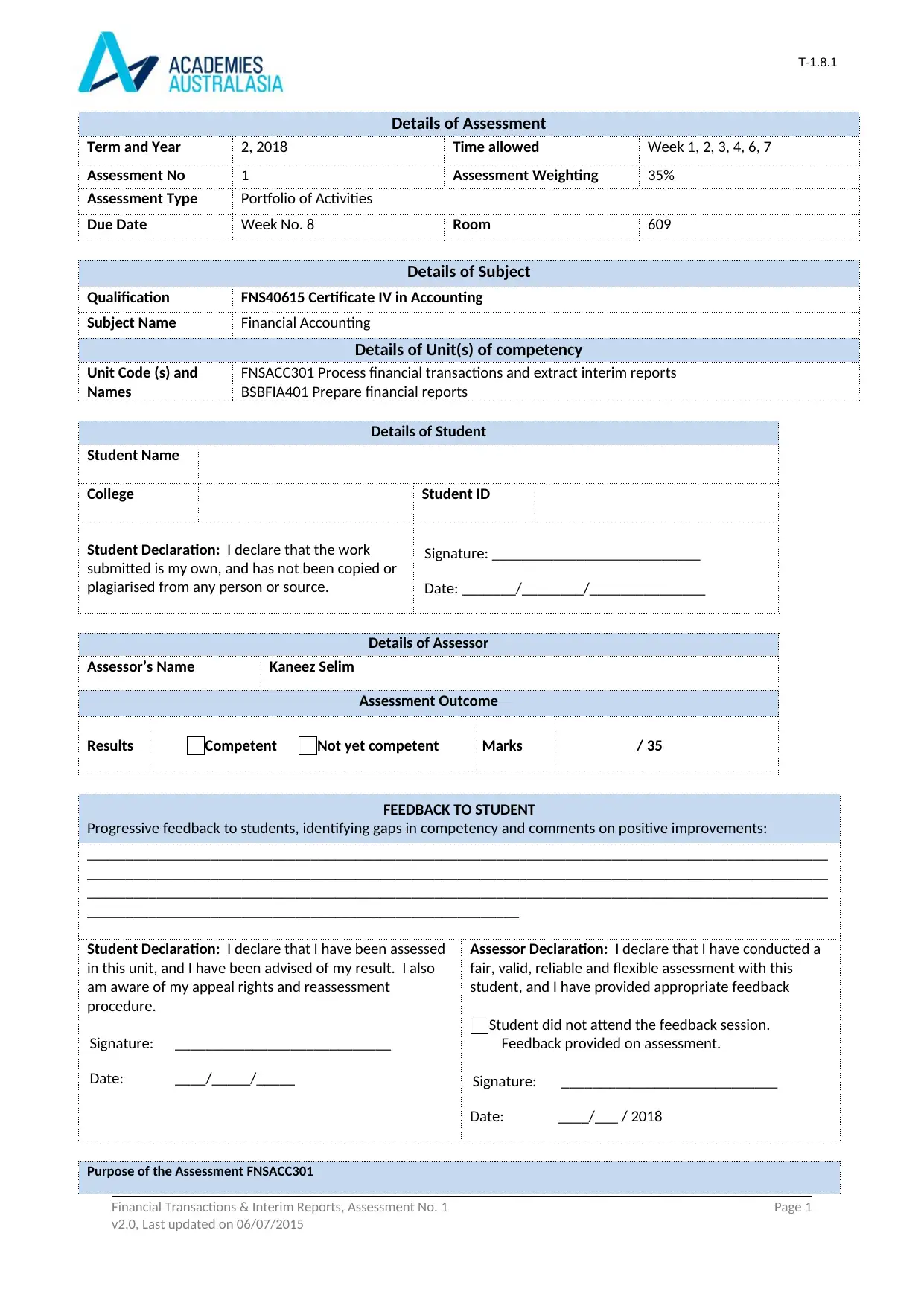
T-1.8.1
Details of Assessment
Term and Year 2, 2018 Time allowed Week 1, 2, 3, 4, 6, 7
Assessment No 1 Assessment Weighting 35%
Assessment Type Portfolio of Activities
Due Date Week No. 8 Room 609
Details of Subject
Qualification FNS40615 Certificate IV in Accounting
Subject Name Financial Accounting
Details of Unit(s) of competency
Unit Code (s) and
Names
FNSACC301 Process financial transactions and extract interim reports
BSBFIA401 Prepare financial reports
Details of Student
Student Name
College Student ID
Student Declaration: I declare that the work
submitted is my own, and has not been copied or
plagiarised from any person or source.
Signature: ___________________________
Date: _______/________/_______________
Details of Assessor
Assessor’s Name Kaneez Selim
Assessment Outcome
Results Competent Not yet competent Marks / 35
FEEDBACK TO STUDENT
Progressive feedback to students, identifying gaps in competency and comments on positive improvements:
________________________________________________________________________________________________
________________________________________________________________________________________________
________________________________________________________________________________________________
________________________________________________________
Student Declaration: I declare that I have been assessed
in this unit, and I have been advised of my result. I also
am aware of my appeal rights and reassessment
procedure.
Signature: ____________________________
Date: ____/_____/_____
Assessor Declaration: I declare that I have conducted a
fair, valid, reliable and flexible assessment with this
student, and I have provided appropriate feedback
Student did not attend the feedback session.
Feedback provided on assessment.
Signature: ____________________________
Date: ____/___ / 2018
Purpose of the Assessment FNSACC301
Financial Transactions & Interim Reports, Assessment No. 1 Page 1
v2.0, Last updated on 06/07/2015
Details of Assessment
Term and Year 2, 2018 Time allowed Week 1, 2, 3, 4, 6, 7
Assessment No 1 Assessment Weighting 35%
Assessment Type Portfolio of Activities
Due Date Week No. 8 Room 609
Details of Subject
Qualification FNS40615 Certificate IV in Accounting
Subject Name Financial Accounting
Details of Unit(s) of competency
Unit Code (s) and
Names
FNSACC301 Process financial transactions and extract interim reports
BSBFIA401 Prepare financial reports
Details of Student
Student Name
College Student ID
Student Declaration: I declare that the work
submitted is my own, and has not been copied or
plagiarised from any person or source.
Signature: ___________________________
Date: _______/________/_______________
Details of Assessor
Assessor’s Name Kaneez Selim
Assessment Outcome
Results Competent Not yet competent Marks / 35
FEEDBACK TO STUDENT
Progressive feedback to students, identifying gaps in competency and comments on positive improvements:
________________________________________________________________________________________________
________________________________________________________________________________________________
________________________________________________________________________________________________
________________________________________________________
Student Declaration: I declare that I have been assessed
in this unit, and I have been advised of my result. I also
am aware of my appeal rights and reassessment
procedure.
Signature: ____________________________
Date: ____/_____/_____
Assessor Declaration: I declare that I have conducted a
fair, valid, reliable and flexible assessment with this
student, and I have provided appropriate feedback
Student did not attend the feedback session.
Feedback provided on assessment.
Signature: ____________________________
Date: ____/___ / 2018
Purpose of the Assessment FNSACC301
Financial Transactions & Interim Reports, Assessment No. 1 Page 1
v2.0, Last updated on 06/07/2015
Paraphrase This Document
Need a fresh take? Get an instant paraphrase of this document with our AI Paraphraser
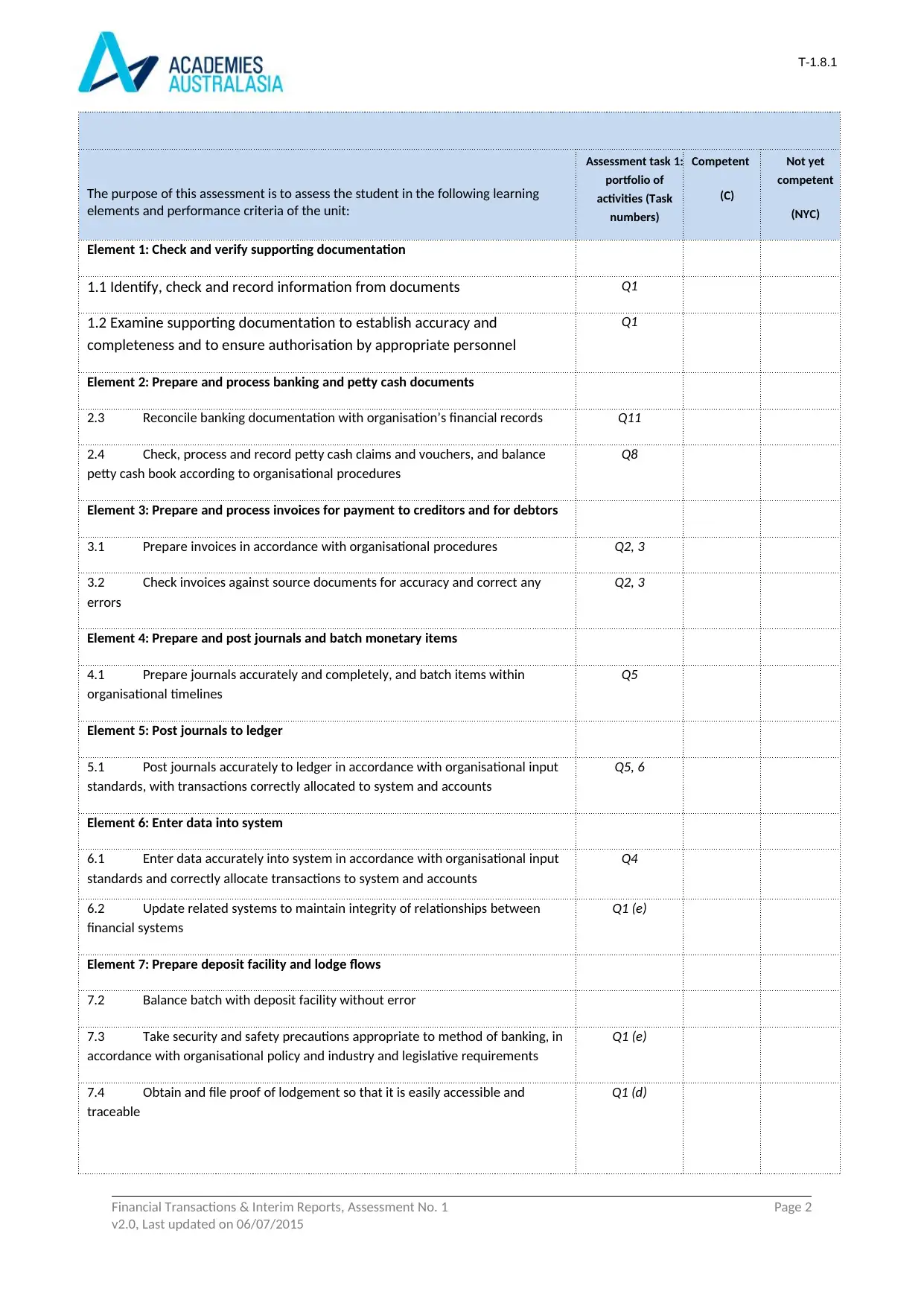
T-1.8.1
The purpose of this assessment is to assess the student in the following learning
elements and performance criteria of the unit:
Assessment task 1:
portfolio of
activities (Task
numbers)
Competent
(C)
Not yet
competent
(NYC)
Element 1: Check and verify supporting documentation
1.1 Identify, check and record information from documents Q1
1.2 Examine supporting documentation to establish accuracy and
completeness and to ensure authorisation by appropriate personnel
Q1
Element 2: Prepare and process banking and petty cash documents
2.3 Reconcile banking documentation with organisation’s financial records Q11
2.4 Check, process and record petty cash claims and vouchers, and balance
petty cash book according to organisational procedures
Q8
Element 3: Prepare and process invoices for payment to creditors and for debtors
3.1 Prepare invoices in accordance with organisational procedures Q2, 3
3.2 Check invoices against source documents for accuracy and correct any
errors
Q2, 3
Element 4: Prepare and post journals and batch monetary items
4.1 Prepare journals accurately and completely, and batch items within
organisational timelines
Q5
Element 5: Post journals to ledger
5.1 Post journals accurately to ledger in accordance with organisational input
standards, with transactions correctly allocated to system and accounts
Q5, 6
Element 6: Enter data into system
6.1 Enter data accurately into system in accordance with organisational input
standards and correctly allocate transactions to system and accounts
Q4
6.2 Update related systems to maintain integrity of relationships between
financial systems
Q1 (e)
Element 7: Prepare deposit facility and lodge flows
7.2 Balance batch with deposit facility without error
7.3 Take security and safety precautions appropriate to method of banking, in
accordance with organisational policy and industry and legislative requirements
Q1 (e)
7.4 Obtain and file proof of lodgement so that it is easily accessible and
traceable
Q1 (d)
Financial Transactions & Interim Reports, Assessment No. 1 Page 2
v2.0, Last updated on 06/07/2015
The purpose of this assessment is to assess the student in the following learning
elements and performance criteria of the unit:
Assessment task 1:
portfolio of
activities (Task
numbers)
Competent
(C)
Not yet
competent
(NYC)
Element 1: Check and verify supporting documentation
1.1 Identify, check and record information from documents Q1
1.2 Examine supporting documentation to establish accuracy and
completeness and to ensure authorisation by appropriate personnel
Q1
Element 2: Prepare and process banking and petty cash documents
2.3 Reconcile banking documentation with organisation’s financial records Q11
2.4 Check, process and record petty cash claims and vouchers, and balance
petty cash book according to organisational procedures
Q8
Element 3: Prepare and process invoices for payment to creditors and for debtors
3.1 Prepare invoices in accordance with organisational procedures Q2, 3
3.2 Check invoices against source documents for accuracy and correct any
errors
Q2, 3
Element 4: Prepare and post journals and batch monetary items
4.1 Prepare journals accurately and completely, and batch items within
organisational timelines
Q5
Element 5: Post journals to ledger
5.1 Post journals accurately to ledger in accordance with organisational input
standards, with transactions correctly allocated to system and accounts
Q5, 6
Element 6: Enter data into system
6.1 Enter data accurately into system in accordance with organisational input
standards and correctly allocate transactions to system and accounts
Q4
6.2 Update related systems to maintain integrity of relationships between
financial systems
Q1 (e)
Element 7: Prepare deposit facility and lodge flows
7.2 Balance batch with deposit facility without error
7.3 Take security and safety precautions appropriate to method of banking, in
accordance with organisational policy and industry and legislative requirements
Q1 (e)
7.4 Obtain and file proof of lodgement so that it is easily accessible and
traceable
Q1 (d)
Financial Transactions & Interim Reports, Assessment No. 1 Page 2
v2.0, Last updated on 06/07/2015
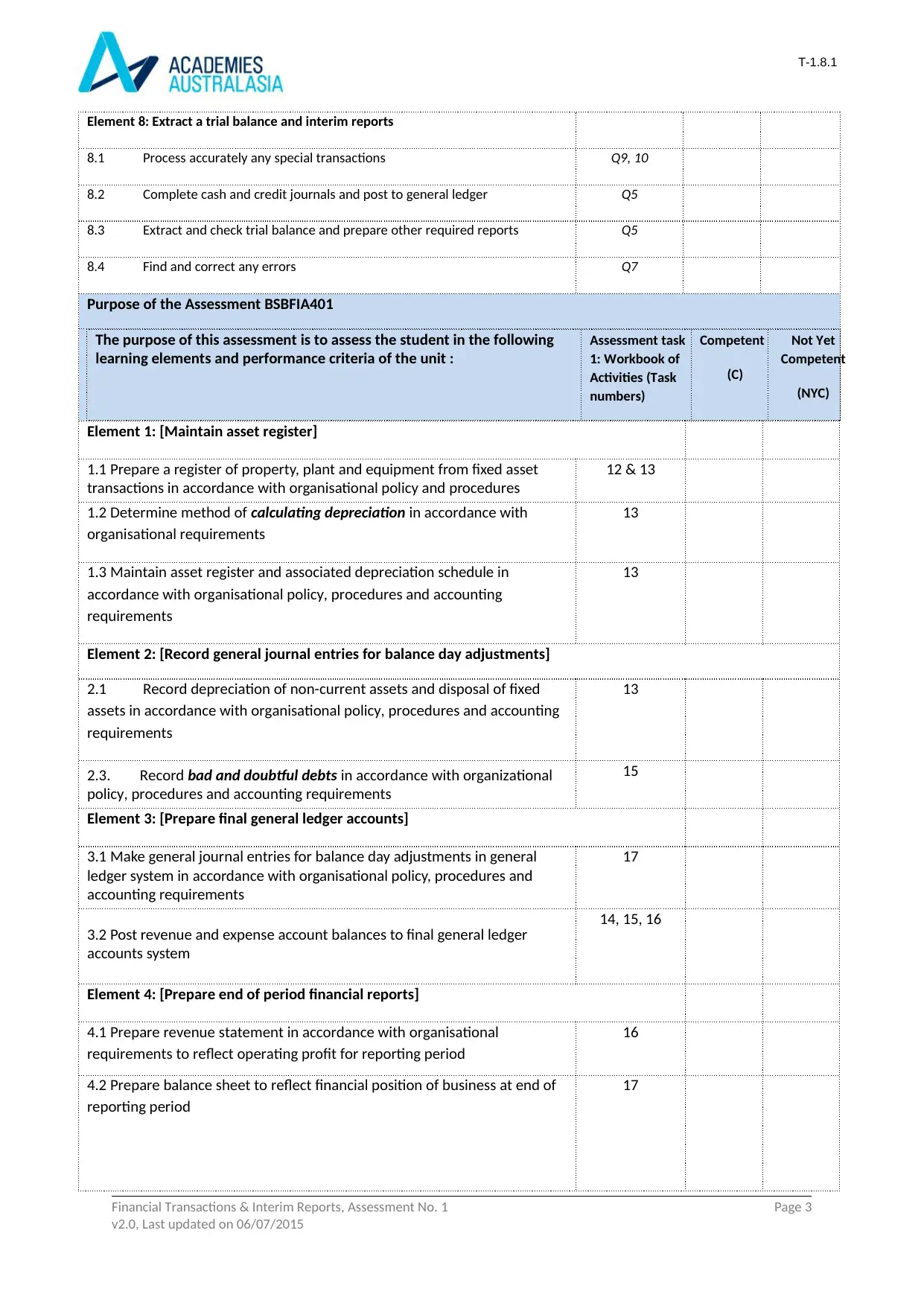
T-1.8.1
Element 8: Extract a trial balance and interim reports
8.1 Process accurately any special transactions Q9, 10
8.2 Complete cash and credit journals and post to general ledger Q5
8.3 Extract and check trial balance and prepare other required reports Q5
8.4 Find and correct any errors Q7
Purpose of the Assessment BSBFIA401
The purpose of this assessment is to assess the student in the following
learning elements and performance criteria of the unit :
Assessment task
1: Workbook of
Activities (Task
numbers)
Competent
(C)
Not Yet
Competent
(NYC)
Element 1: [Maintain asset register]
1.1 Prepare a register of property, plant and equipment from fixed asset
transactions in accordance with organisational policy and procedures
12 & 13
1.2 Determine method of calculating depreciation in accordance with
organisational requirements
13
1.3 Maintain asset register and associated depreciation schedule in
accordance with organisational policy, procedures and accounting
requirements
13
Element 2: [Record general journal entries for balance day adjustments]
2.1 Record depreciation of non-current assets and disposal of fixed
assets in accordance with organisational policy, procedures and accounting
requirements
13
2.3. Record bad and doubtful debts in accordance with organizational
policy, procedures and accounting requirements
15
Element 3: [Prepare final general ledger accounts]
3.1 Make general journal entries for balance day adjustments in general
ledger system in accordance with organisational policy, procedures and
accounting requirements
17
3.2 Post revenue and expense account balances to final general ledger
accounts system
14, 15, 16
Element 4: [Prepare end of period financial reports]
4.1 Prepare revenue statement in accordance with organisational
requirements to reflect operating profit for reporting period
16
4.2 Prepare balance sheet to reflect financial position of business at end of
reporting period
17
Financial Transactions & Interim Reports, Assessment No. 1 Page 3
v2.0, Last updated on 06/07/2015
Element 8: Extract a trial balance and interim reports
8.1 Process accurately any special transactions Q9, 10
8.2 Complete cash and credit journals and post to general ledger Q5
8.3 Extract and check trial balance and prepare other required reports Q5
8.4 Find and correct any errors Q7
Purpose of the Assessment BSBFIA401
The purpose of this assessment is to assess the student in the following
learning elements and performance criteria of the unit :
Assessment task
1: Workbook of
Activities (Task
numbers)
Competent
(C)
Not Yet
Competent
(NYC)
Element 1: [Maintain asset register]
1.1 Prepare a register of property, plant and equipment from fixed asset
transactions in accordance with organisational policy and procedures
12 & 13
1.2 Determine method of calculating depreciation in accordance with
organisational requirements
13
1.3 Maintain asset register and associated depreciation schedule in
accordance with organisational policy, procedures and accounting
requirements
13
Element 2: [Record general journal entries for balance day adjustments]
2.1 Record depreciation of non-current assets and disposal of fixed
assets in accordance with organisational policy, procedures and accounting
requirements
13
2.3. Record bad and doubtful debts in accordance with organizational
policy, procedures and accounting requirements
15
Element 3: [Prepare final general ledger accounts]
3.1 Make general journal entries for balance day adjustments in general
ledger system in accordance with organisational policy, procedures and
accounting requirements
17
3.2 Post revenue and expense account balances to final general ledger
accounts system
14, 15, 16
Element 4: [Prepare end of period financial reports]
4.1 Prepare revenue statement in accordance with organisational
requirements to reflect operating profit for reporting period
16
4.2 Prepare balance sheet to reflect financial position of business at end of
reporting period
17
Financial Transactions & Interim Reports, Assessment No. 1 Page 3
v2.0, Last updated on 06/07/2015
⊘ This is a preview!⊘
Do you want full access?
Subscribe today to unlock all pages.

Trusted by 1+ million students worldwide
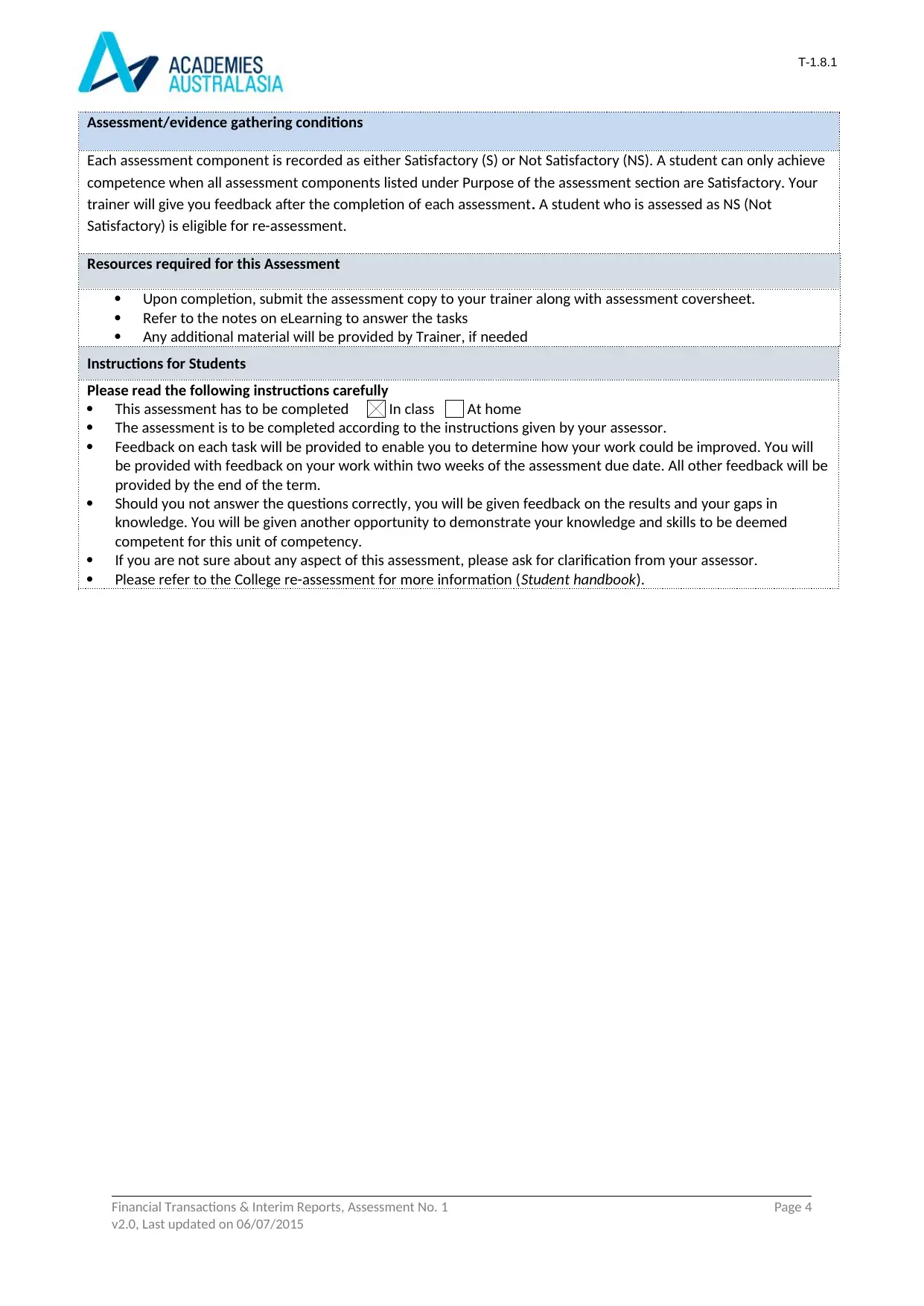
T-1.8.1
Assessment/evidence gathering conditions
Each assessment component is recorded as either Satisfactory (S) or Not Satisfactory (NS). A student can only achieve
competence when all assessment components listed under Purpose of the assessment section are Satisfactory. Your
trainer will give you feedback after the completion of each assessment. A student who is assessed as NS (Not
Satisfactory) is eligible for re-assessment.
Resources required for this Assessment
Upon completion, submit the assessment copy to your trainer along with assessment coversheet.
Refer to the notes on eLearning to answer the tasks
Any additional material will be provided by Trainer, if needed
Instructions for Students
Please read the following instructions carefully
This assessment has to be completed In class At home
The assessment is to be completed according to the instructions given by your assessor.
Feedback on each task will be provided to enable you to determine how your work could be improved. You will
be provided with feedback on your work within two weeks of the assessment due date. All other feedback will be
provided by the end of the term.
Should you not answer the questions correctly, you will be given feedback on the results and your gaps in
knowledge. You will be given another opportunity to demonstrate your knowledge and skills to be deemed
competent for this unit of competency.
If you are not sure about any aspect of this assessment, please ask for clarification from your assessor.
Please refer to the College re-assessment for more information (Student handbook).
Financial Transactions & Interim Reports, Assessment No. 1 Page 4
v2.0, Last updated on 06/07/2015
Assessment/evidence gathering conditions
Each assessment component is recorded as either Satisfactory (S) or Not Satisfactory (NS). A student can only achieve
competence when all assessment components listed under Purpose of the assessment section are Satisfactory. Your
trainer will give you feedback after the completion of each assessment. A student who is assessed as NS (Not
Satisfactory) is eligible for re-assessment.
Resources required for this Assessment
Upon completion, submit the assessment copy to your trainer along with assessment coversheet.
Refer to the notes on eLearning to answer the tasks
Any additional material will be provided by Trainer, if needed
Instructions for Students
Please read the following instructions carefully
This assessment has to be completed In class At home
The assessment is to be completed according to the instructions given by your assessor.
Feedback on each task will be provided to enable you to determine how your work could be improved. You will
be provided with feedback on your work within two weeks of the assessment due date. All other feedback will be
provided by the end of the term.
Should you not answer the questions correctly, you will be given feedback on the results and your gaps in
knowledge. You will be given another opportunity to demonstrate your knowledge and skills to be deemed
competent for this unit of competency.
If you are not sure about any aspect of this assessment, please ask for clarification from your assessor.
Please refer to the College re-assessment for more information (Student handbook).
Financial Transactions & Interim Reports, Assessment No. 1 Page 4
v2.0, Last updated on 06/07/2015
Paraphrase This Document
Need a fresh take? Get an instant paraphrase of this document with our AI Paraphraser
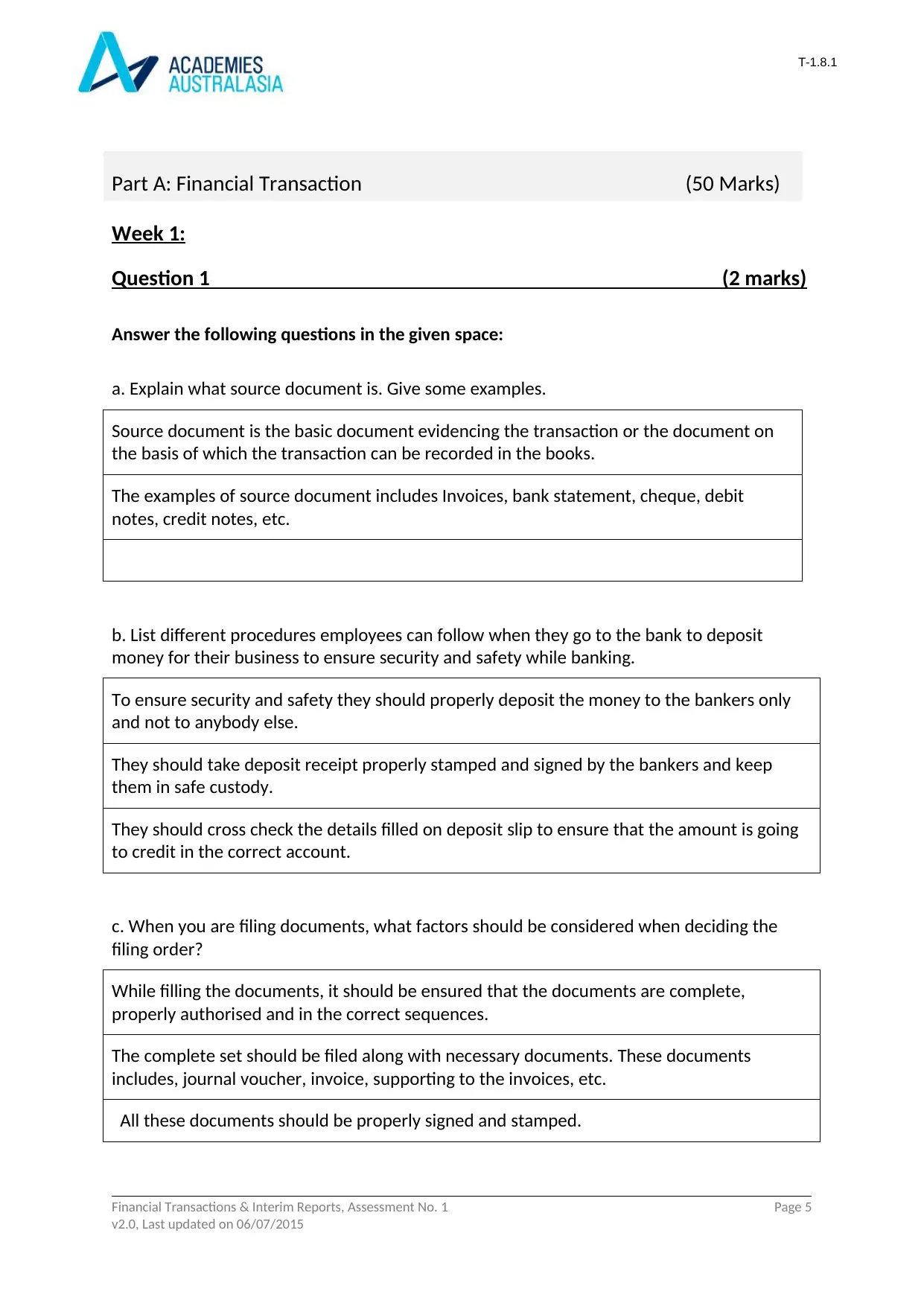
T-1.8.1
Part A: Financial Transaction (50 Marks)
Week 1:
Question 1 (2 marks)
Answer the following questions in the given space:
a. Explain what source document is. Give some examples.
Source document is the basic document evidencing the transaction or the document on
the basis of which the transaction can be recorded in the books.
The examples of source document includes Invoices, bank statement, cheque, debit
notes, credit notes, etc.
b. List different procedures employees can follow when they go to the bank to deposit
money for their business to ensure security and safety while banking.
To ensure security and safety they should properly deposit the money to the bankers only
and not to anybody else.
They should take deposit receipt properly stamped and signed by the bankers and keep
them in safe custody.
They should cross check the details filled on deposit slip to ensure that the amount is going
to credit in the correct account.
c. When you are filing documents, what factors should be considered when deciding the
filing order?
While filling the documents, it should be ensured that the documents are complete,
properly authorised and in the correct sequences.
The complete set should be filed along with necessary documents. These documents
includes, journal voucher, invoice, supporting to the invoices, etc.
All these documents should be properly signed and stamped.
Financial Transactions & Interim Reports, Assessment No. 1 Page 5
v2.0, Last updated on 06/07/2015
Part A: Financial Transaction (50 Marks)
Week 1:
Question 1 (2 marks)
Answer the following questions in the given space:
a. Explain what source document is. Give some examples.
Source document is the basic document evidencing the transaction or the document on
the basis of which the transaction can be recorded in the books.
The examples of source document includes Invoices, bank statement, cheque, debit
notes, credit notes, etc.
b. List different procedures employees can follow when they go to the bank to deposit
money for their business to ensure security and safety while banking.
To ensure security and safety they should properly deposit the money to the bankers only
and not to anybody else.
They should take deposit receipt properly stamped and signed by the bankers and keep
them in safe custody.
They should cross check the details filled on deposit slip to ensure that the amount is going
to credit in the correct account.
c. When you are filing documents, what factors should be considered when deciding the
filing order?
While filling the documents, it should be ensured that the documents are complete,
properly authorised and in the correct sequences.
The complete set should be filed along with necessary documents. These documents
includes, journal voucher, invoice, supporting to the invoices, etc.
All these documents should be properly signed and stamped.
Financial Transactions & Interim Reports, Assessment No. 1 Page 5
v2.0, Last updated on 06/07/2015
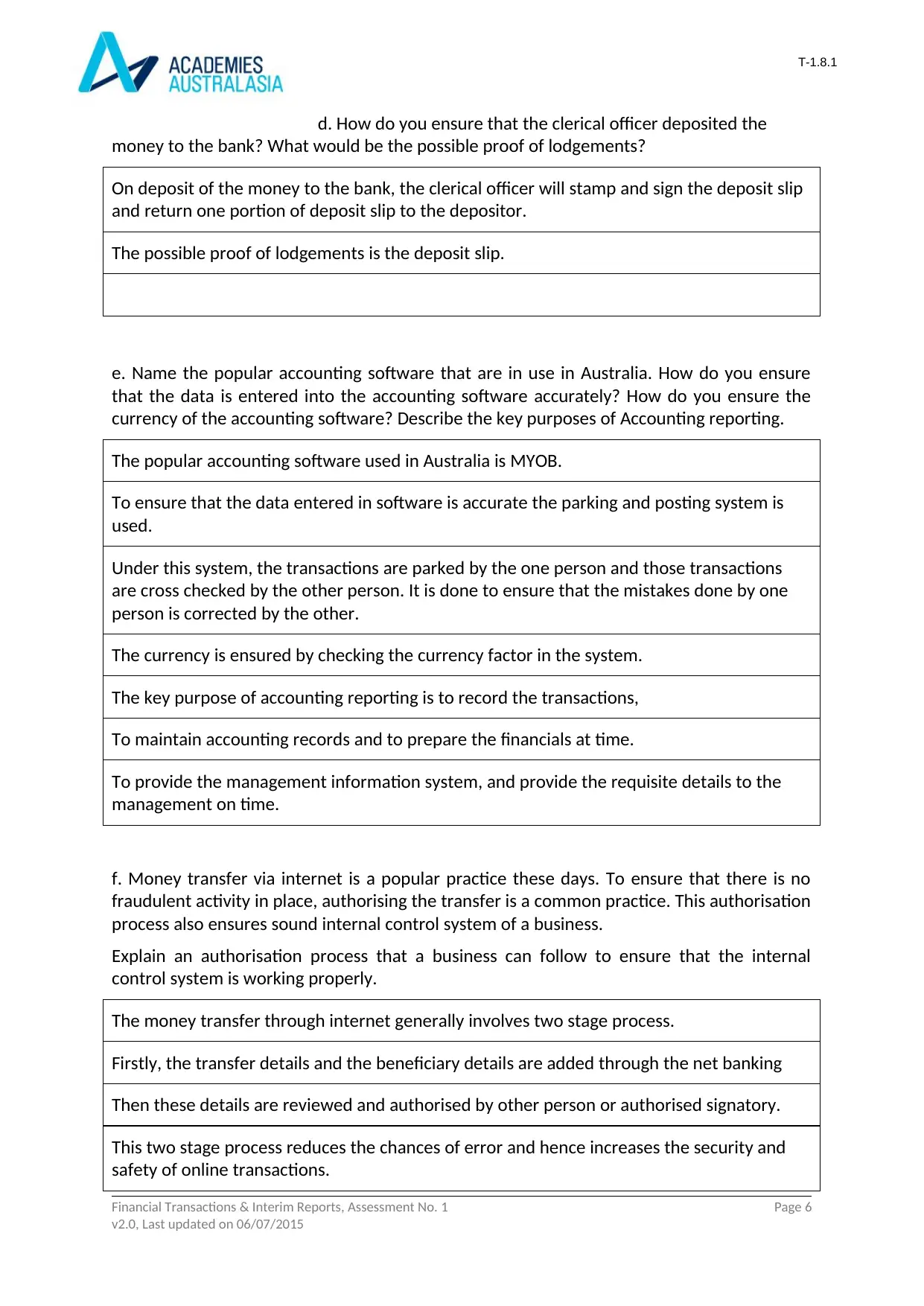
T-1.8.1
d. How do you ensure that the clerical officer deposited the
money to the bank? What would be the possible proof of lodgements?
On deposit of the money to the bank, the clerical officer will stamp and sign the deposit slip
and return one portion of deposit slip to the depositor.
The possible proof of lodgements is the deposit slip.
e. Name the popular accounting software that are in use in Australia. How do you ensure
that the data is entered into the accounting software accurately? How do you ensure the
currency of the accounting software? Describe the key purposes of Accounting reporting.
The popular accounting software used in Australia is MYOB.
To ensure that the data entered in software is accurate the parking and posting system is
used.
Under this system, the transactions are parked by the one person and those transactions
are cross checked by the other person. It is done to ensure that the mistakes done by one
person is corrected by the other.
The currency is ensured by checking the currency factor in the system.
The key purpose of accounting reporting is to record the transactions,
To maintain accounting records and to prepare the financials at time.
To provide the management information system, and provide the requisite details to the
management on time.
f. Money transfer via internet is a popular practice these days. To ensure that there is no
fraudulent activity in place, authorising the transfer is a common practice. This authorisation
process also ensures sound internal control system of a business.
Explain an authorisation process that a business can follow to ensure that the internal
control system is working properly.
The money transfer through internet generally involves two stage process.
Firstly, the transfer details and the beneficiary details are added through the net banking
Then these details are reviewed and authorised by other person or authorised signatory.
This two stage process reduces the chances of error and hence increases the security and
safety of online transactions.
Financial Transactions & Interim Reports, Assessment No. 1 Page 6
v2.0, Last updated on 06/07/2015
d. How do you ensure that the clerical officer deposited the
money to the bank? What would be the possible proof of lodgements?
On deposit of the money to the bank, the clerical officer will stamp and sign the deposit slip
and return one portion of deposit slip to the depositor.
The possible proof of lodgements is the deposit slip.
e. Name the popular accounting software that are in use in Australia. How do you ensure
that the data is entered into the accounting software accurately? How do you ensure the
currency of the accounting software? Describe the key purposes of Accounting reporting.
The popular accounting software used in Australia is MYOB.
To ensure that the data entered in software is accurate the parking and posting system is
used.
Under this system, the transactions are parked by the one person and those transactions
are cross checked by the other person. It is done to ensure that the mistakes done by one
person is corrected by the other.
The currency is ensured by checking the currency factor in the system.
The key purpose of accounting reporting is to record the transactions,
To maintain accounting records and to prepare the financials at time.
To provide the management information system, and provide the requisite details to the
management on time.
f. Money transfer via internet is a popular practice these days. To ensure that there is no
fraudulent activity in place, authorising the transfer is a common practice. This authorisation
process also ensures sound internal control system of a business.
Explain an authorisation process that a business can follow to ensure that the internal
control system is working properly.
The money transfer through internet generally involves two stage process.
Firstly, the transfer details and the beneficiary details are added through the net banking
Then these details are reviewed and authorised by other person or authorised signatory.
This two stage process reduces the chances of error and hence increases the security and
safety of online transactions.
Financial Transactions & Interim Reports, Assessment No. 1 Page 6
v2.0, Last updated on 06/07/2015
⊘ This is a preview!⊘
Do you want full access?
Subscribe today to unlock all pages.

Trusted by 1+ million students worldwide
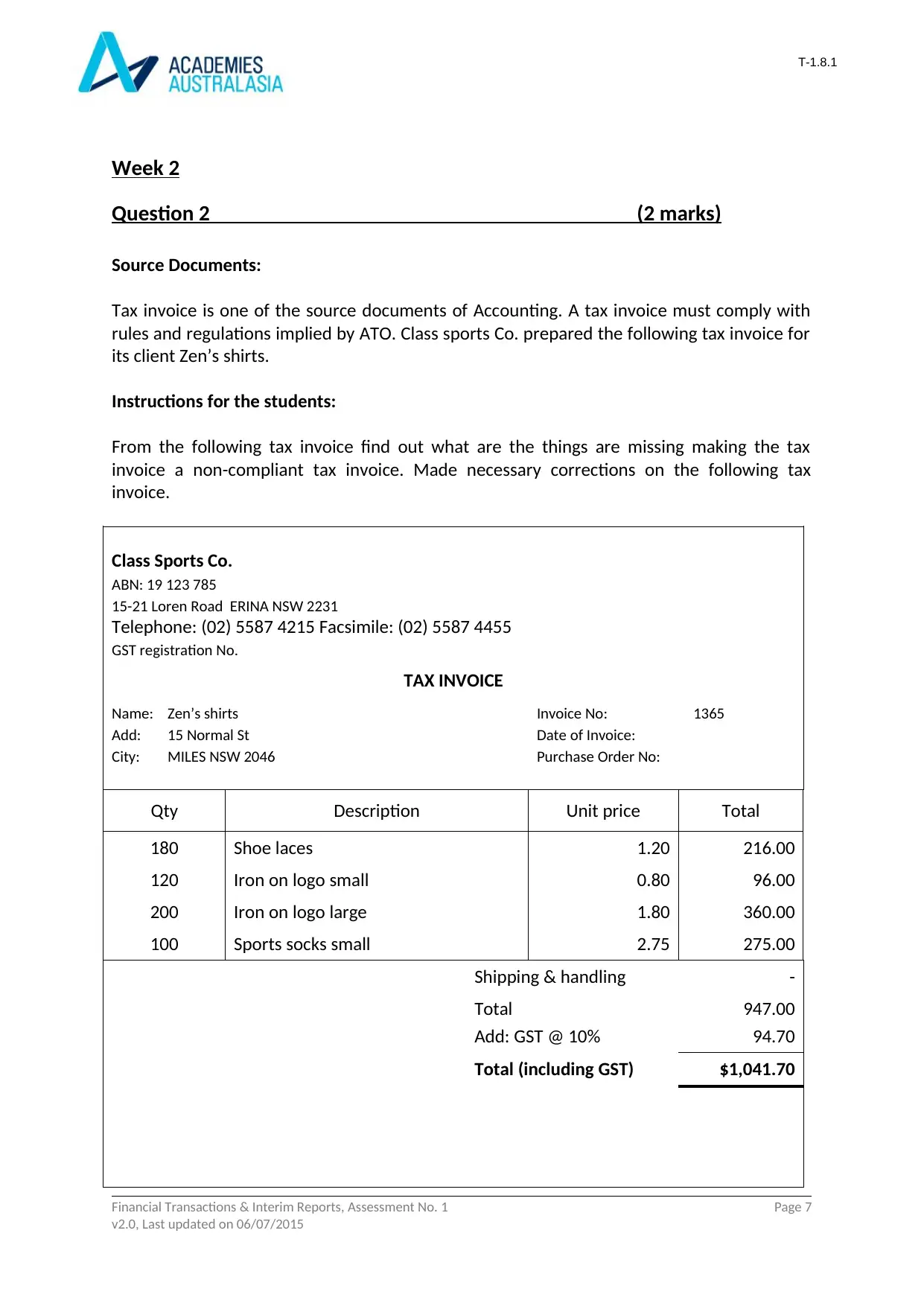
T-1.8.1
Week 2
Question 2 (2 marks)
Source Documents:
Tax invoice is one of the source documents of Accounting. A tax invoice must comply with
rules and regulations implied by ATO. Class sports Co. prepared the following tax invoice for
its client Zen’s shirts.
Instructions for the students:
From the following tax invoice find out what are the things are missing making the tax
invoice a non-compliant tax invoice. Made necessary corrections on the following tax
invoice.
Class Sports Co.
ABN: 19 123 785
15-21 Loren Road ERINA NSW 2231
Telephone: (02) 5587 4215 Facsimile: (02) 5587 4455
GST registration No.
TAX INVOICE
Name: Zen’s shirts
Add: 15 Normal St
City: MILES NSW 2046
Invoice No: 1365
Date of Invoice:
Purchase Order No:
Qty Description Unit price Total
180 Shoe laces 1.20 216.00
120 Iron on logo small 0.80 96.00
200 Iron on logo large 1.80 360.00
100 Sports socks small 2.75 275.00
Shipping & handling -
Total
Add: GST @ 10%
947.00
94.70
Total (including GST) $1,041.70
Financial Transactions & Interim Reports, Assessment No. 1 Page 7
v2.0, Last updated on 06/07/2015
Week 2
Question 2 (2 marks)
Source Documents:
Tax invoice is one of the source documents of Accounting. A tax invoice must comply with
rules and regulations implied by ATO. Class sports Co. prepared the following tax invoice for
its client Zen’s shirts.
Instructions for the students:
From the following tax invoice find out what are the things are missing making the tax
invoice a non-compliant tax invoice. Made necessary corrections on the following tax
invoice.
Class Sports Co.
ABN: 19 123 785
15-21 Loren Road ERINA NSW 2231
Telephone: (02) 5587 4215 Facsimile: (02) 5587 4455
GST registration No.
TAX INVOICE
Name: Zen’s shirts
Add: 15 Normal St
City: MILES NSW 2046
Invoice No: 1365
Date of Invoice:
Purchase Order No:
Qty Description Unit price Total
180 Shoe laces 1.20 216.00
120 Iron on logo small 0.80 96.00
200 Iron on logo large 1.80 360.00
100 Sports socks small 2.75 275.00
Shipping & handling -
Total
Add: GST @ 10%
947.00
94.70
Total (including GST) $1,041.70
Financial Transactions & Interim Reports, Assessment No. 1 Page 7
v2.0, Last updated on 06/07/2015
Paraphrase This Document
Need a fresh take? Get an instant paraphrase of this document with our AI Paraphraser
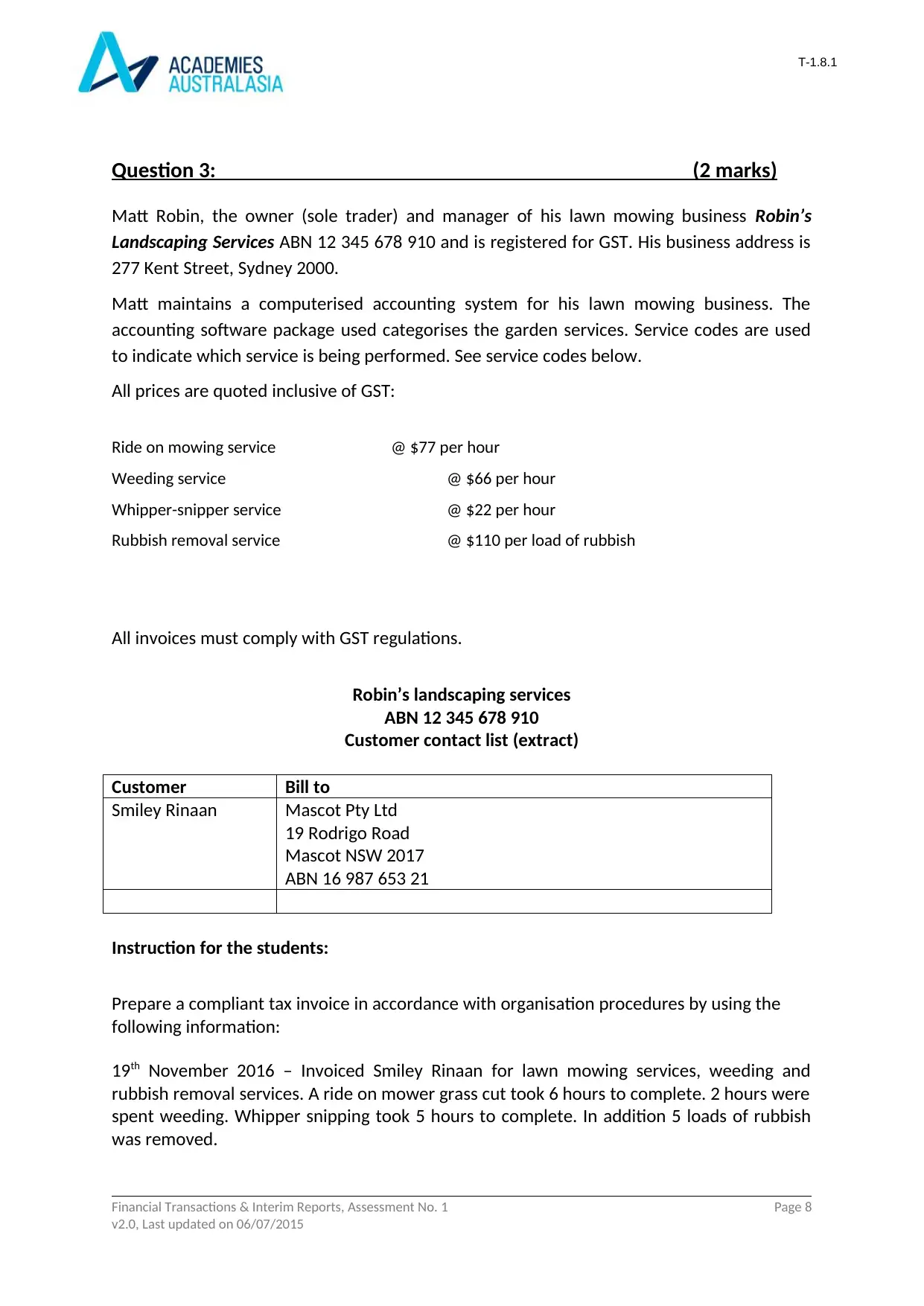
T-1.8.1
Question 3: (2 marks)
Matt Robin, the owner (sole trader) and manager of his lawn mowing business Robin’s
Landscaping Services ABN 12 345 678 910 and is registered for GST. His business address is
277 Kent Street, Sydney 2000.
Matt maintains a computerised accounting system for his lawn mowing business. The
accounting software package used categorises the garden services. Service codes are used
to indicate which service is being performed. See service codes below.
All prices are quoted inclusive of GST:
Ride on mowing service @ $77 per hour
Weeding service @ $66 per hour
Whipper-snipper service @ $22 per hour
Rubbish removal service @ $110 per load of rubbish
All invoices must comply with GST regulations.
Robin’s landscaping services
ABN 12 345 678 910
Customer contact list (extract)
Customer Bill to
Smiley Rinaan Mascot Pty Ltd
19 Rodrigo Road
Mascot NSW 2017
ABN 16 987 653 21
Instruction for the students:
Prepare a compliant tax invoice in accordance with organisation procedures by using the
following information:
19th November 2016 – Invoiced Smiley Rinaan for lawn mowing services, weeding and
rubbish removal services. A ride on mower grass cut took 6 hours to complete. 2 hours were
spent weeding. Whipper snipping took 5 hours to complete. In addition 5 loads of rubbish
was removed.
Financial Transactions & Interim Reports, Assessment No. 1 Page 8
v2.0, Last updated on 06/07/2015
Question 3: (2 marks)
Matt Robin, the owner (sole trader) and manager of his lawn mowing business Robin’s
Landscaping Services ABN 12 345 678 910 and is registered for GST. His business address is
277 Kent Street, Sydney 2000.
Matt maintains a computerised accounting system for his lawn mowing business. The
accounting software package used categorises the garden services. Service codes are used
to indicate which service is being performed. See service codes below.
All prices are quoted inclusive of GST:
Ride on mowing service @ $77 per hour
Weeding service @ $66 per hour
Whipper-snipper service @ $22 per hour
Rubbish removal service @ $110 per load of rubbish
All invoices must comply with GST regulations.
Robin’s landscaping services
ABN 12 345 678 910
Customer contact list (extract)
Customer Bill to
Smiley Rinaan Mascot Pty Ltd
19 Rodrigo Road
Mascot NSW 2017
ABN 16 987 653 21
Instruction for the students:
Prepare a compliant tax invoice in accordance with organisation procedures by using the
following information:
19th November 2016 – Invoiced Smiley Rinaan for lawn mowing services, weeding and
rubbish removal services. A ride on mower grass cut took 6 hours to complete. 2 hours were
spent weeding. Whipper snipping took 5 hours to complete. In addition 5 loads of rubbish
was removed.
Financial Transactions & Interim Reports, Assessment No. 1 Page 8
v2.0, Last updated on 06/07/2015
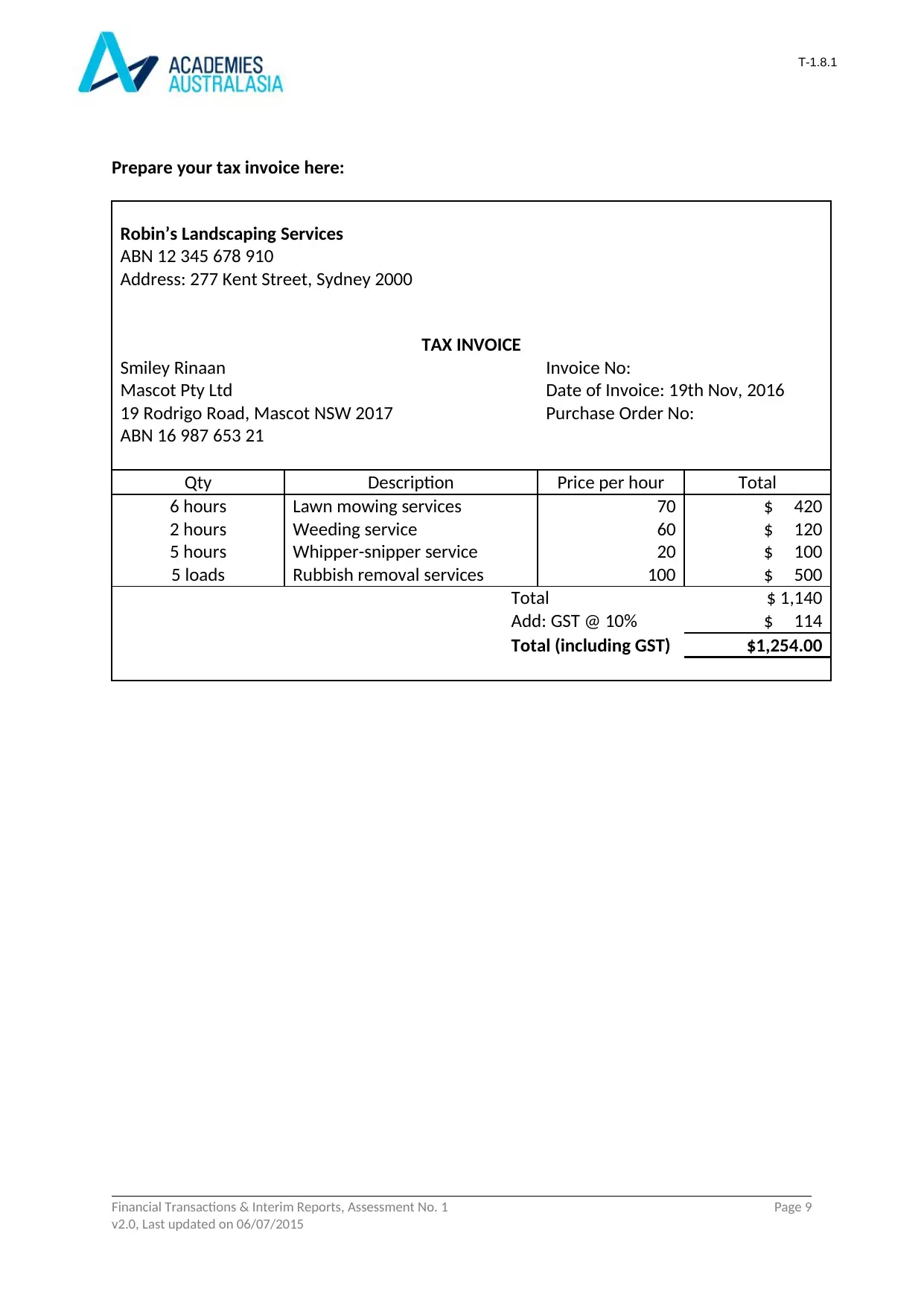
T-1.8.1
Prepare your tax invoice here:
Robin’s Landscaping Services
ABN 12 345 678 910
Address: 277 Kent Street, Sydney 2000
TAX INVOICE
Smiley Rinaan Invoice No:
Mascot Pty Ltd Date of Invoice: 19th Nov, 2016
19 Rodrigo Road, Mascot NSW 2017 Purchase Order No:
ABN 16 987 653 21
Qty Description Price per hour Total
6 hours Lawn mowing services 70 $ 420
2 hours Weeding service 60 $ 120
5 hours Whipper-snipper service 20 $ 100
5 loads Rubbish removal services 100 $ 500
Total $ 1,140
Add: GST @ 10% $ 114
Total (including GST) $1,254.00
Financial Transactions & Interim Reports, Assessment No. 1 Page 9
v2.0, Last updated on 06/07/2015
Prepare your tax invoice here:
Robin’s Landscaping Services
ABN 12 345 678 910
Address: 277 Kent Street, Sydney 2000
TAX INVOICE
Smiley Rinaan Invoice No:
Mascot Pty Ltd Date of Invoice: 19th Nov, 2016
19 Rodrigo Road, Mascot NSW 2017 Purchase Order No:
ABN 16 987 653 21
Qty Description Price per hour Total
6 hours Lawn mowing services 70 $ 420
2 hours Weeding service 60 $ 120
5 hours Whipper-snipper service 20 $ 100
5 loads Rubbish removal services 100 $ 500
Total $ 1,140
Add: GST @ 10% $ 114
Total (including GST) $1,254.00
Financial Transactions & Interim Reports, Assessment No. 1 Page 9
v2.0, Last updated on 06/07/2015
⊘ This is a preview!⊘
Do you want full access?
Subscribe today to unlock all pages.

Trusted by 1+ million students worldwide
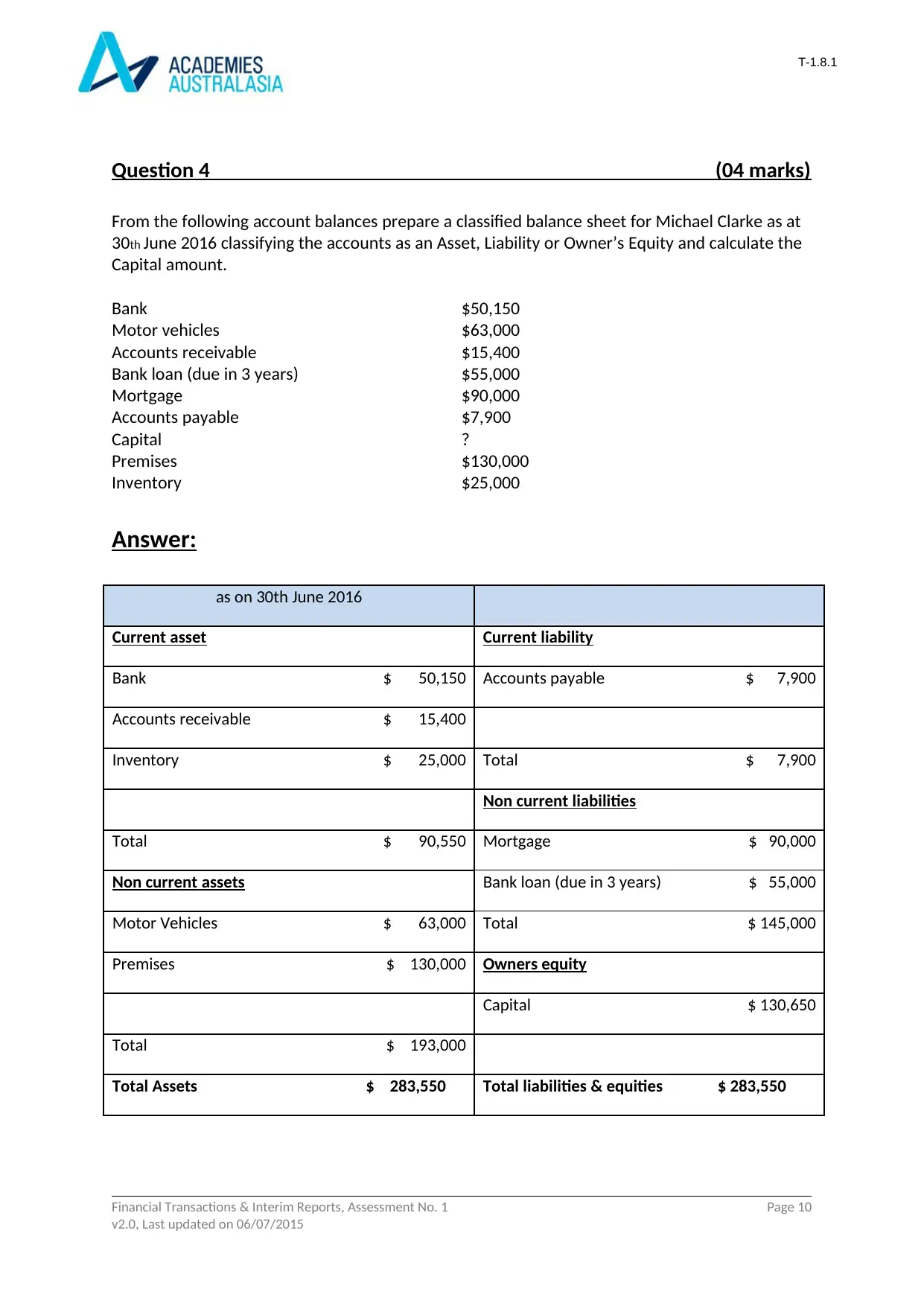
T-1.8.1
Question 4 (04 marks)
From the following account balances prepare a classified balance sheet for Michael Clarke as at
30th June 2016 classifying the accounts as an Asset, Liability or Owner’s Equity and calculate the
Capital amount.
Bank $50,150
Motor vehicles $63,000
Accounts receivable $15,400
Bank loan (due in 3 years) $55,000
Mortgage $90,000
Accounts payable $7,900
Capital ?
Premises $130,000
Inventory $25,000
Answer:
as on 30th June 2016
Current asset Current liability
Bank $ 50,150 Accounts payable $ 7,900
Accounts receivable $ 15,400
Inventory $ 25,000 Total $ 7,900
Non current liabilities
Total $ 90,550 Mortgage $ 90,000
Non current assets Bank loan (due in 3 years) $ 55,000
Motor Vehicles $ 63,000 Total $ 145,000
Premises $ 130,000 Owners equity
Capital $ 130,650
Total $ 193,000
Total Assets $ 283,550 Total liabilities & equities $ 283,550
Financial Transactions & Interim Reports, Assessment No. 1 Page 10
v2.0, Last updated on 06/07/2015
Question 4 (04 marks)
From the following account balances prepare a classified balance sheet for Michael Clarke as at
30th June 2016 classifying the accounts as an Asset, Liability or Owner’s Equity and calculate the
Capital amount.
Bank $50,150
Motor vehicles $63,000
Accounts receivable $15,400
Bank loan (due in 3 years) $55,000
Mortgage $90,000
Accounts payable $7,900
Capital ?
Premises $130,000
Inventory $25,000
Answer:
as on 30th June 2016
Current asset Current liability
Bank $ 50,150 Accounts payable $ 7,900
Accounts receivable $ 15,400
Inventory $ 25,000 Total $ 7,900
Non current liabilities
Total $ 90,550 Mortgage $ 90,000
Non current assets Bank loan (due in 3 years) $ 55,000
Motor Vehicles $ 63,000 Total $ 145,000
Premises $ 130,000 Owners equity
Capital $ 130,650
Total $ 193,000
Total Assets $ 283,550 Total liabilities & equities $ 283,550
Financial Transactions & Interim Reports, Assessment No. 1 Page 10
v2.0, Last updated on 06/07/2015
Paraphrase This Document
Need a fresh take? Get an instant paraphrase of this document with our AI Paraphraser
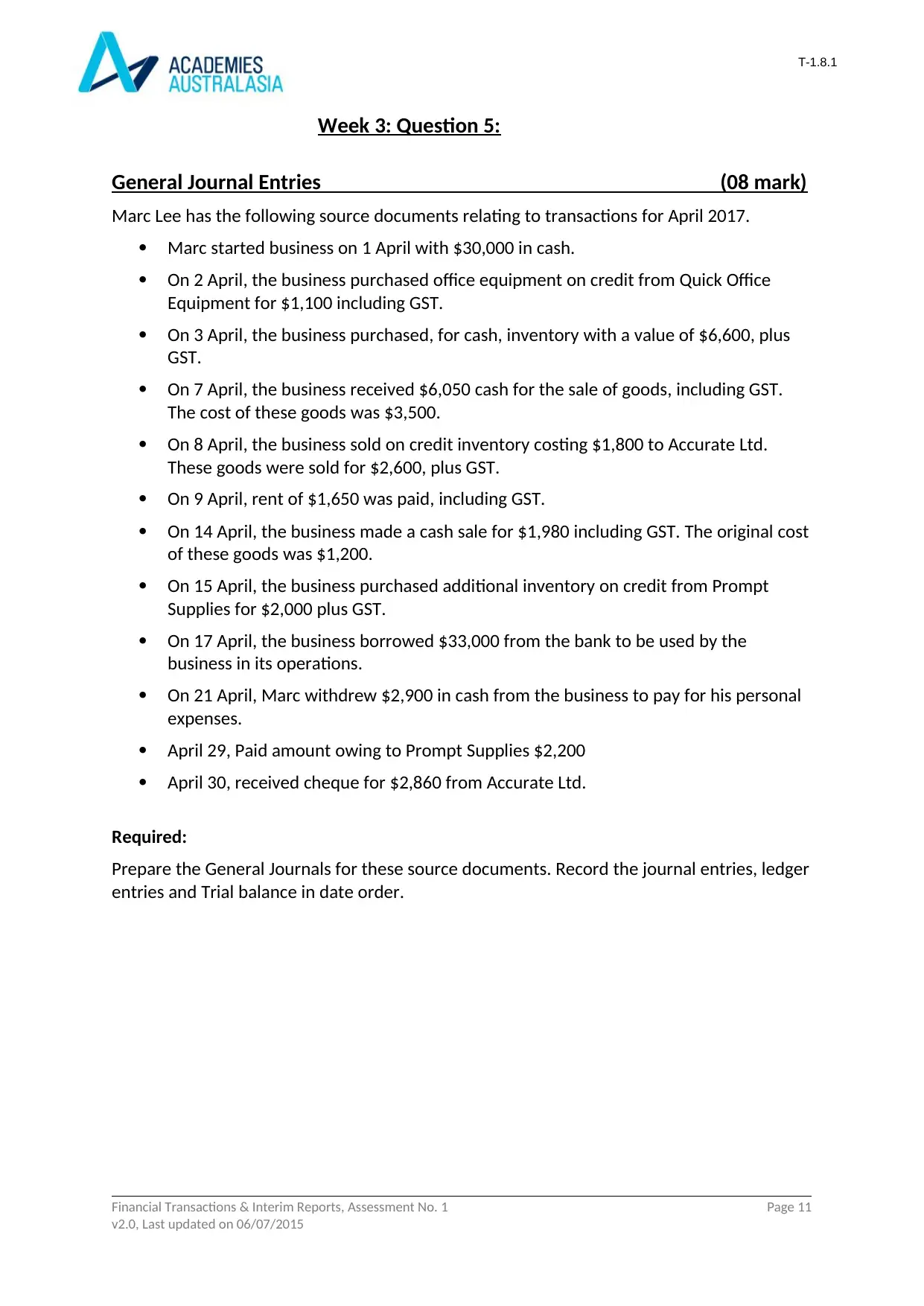
T-1.8.1
Week 3: Question 5:
General Journal Entries (08 mark)
Marc Lee has the following source documents relating to transactions for April 2017.
Marc started business on 1 April with $30,000 in cash.
On 2 April, the business purchased office equipment on credit from Quick Office
Equipment for $1,100 including GST.
On 3 April, the business purchased, for cash, inventory with a value of $6,600, plus
GST.
On 7 April, the business received $6,050 cash for the sale of goods, including GST.
The cost of these goods was $3,500.
On 8 April, the business sold on credit inventory costing $1,800 to Accurate Ltd.
These goods were sold for $2,600, plus GST.
On 9 April, rent of $1,650 was paid, including GST.
On 14 April, the business made a cash sale for $1,980 including GST. The original cost
of these goods was $1,200.
On 15 April, the business purchased additional inventory on credit from Prompt
Supplies for $2,000 plus GST.
On 17 April, the business borrowed $33,000 from the bank to be used by the
business in its operations.
On 21 April, Marc withdrew $2,900 in cash from the business to pay for his personal
expenses.
April 29, Paid amount owing to Prompt Supplies $2,200
April 30, received cheque for $2,860 from Accurate Ltd.
Required:
Prepare the General Journals for these source documents. Record the journal entries, ledger
entries and Trial balance in date order.
Financial Transactions & Interim Reports, Assessment No. 1 Page 11
v2.0, Last updated on 06/07/2015
Week 3: Question 5:
General Journal Entries (08 mark)
Marc Lee has the following source documents relating to transactions for April 2017.
Marc started business on 1 April with $30,000 in cash.
On 2 April, the business purchased office equipment on credit from Quick Office
Equipment for $1,100 including GST.
On 3 April, the business purchased, for cash, inventory with a value of $6,600, plus
GST.
On 7 April, the business received $6,050 cash for the sale of goods, including GST.
The cost of these goods was $3,500.
On 8 April, the business sold on credit inventory costing $1,800 to Accurate Ltd.
These goods were sold for $2,600, plus GST.
On 9 April, rent of $1,650 was paid, including GST.
On 14 April, the business made a cash sale for $1,980 including GST. The original cost
of these goods was $1,200.
On 15 April, the business purchased additional inventory on credit from Prompt
Supplies for $2,000 plus GST.
On 17 April, the business borrowed $33,000 from the bank to be used by the
business in its operations.
On 21 April, Marc withdrew $2,900 in cash from the business to pay for his personal
expenses.
April 29, Paid amount owing to Prompt Supplies $2,200
April 30, received cheque for $2,860 from Accurate Ltd.
Required:
Prepare the General Journals for these source documents. Record the journal entries, ledger
entries and Trial balance in date order.
Financial Transactions & Interim Reports, Assessment No. 1 Page 11
v2.0, Last updated on 06/07/2015
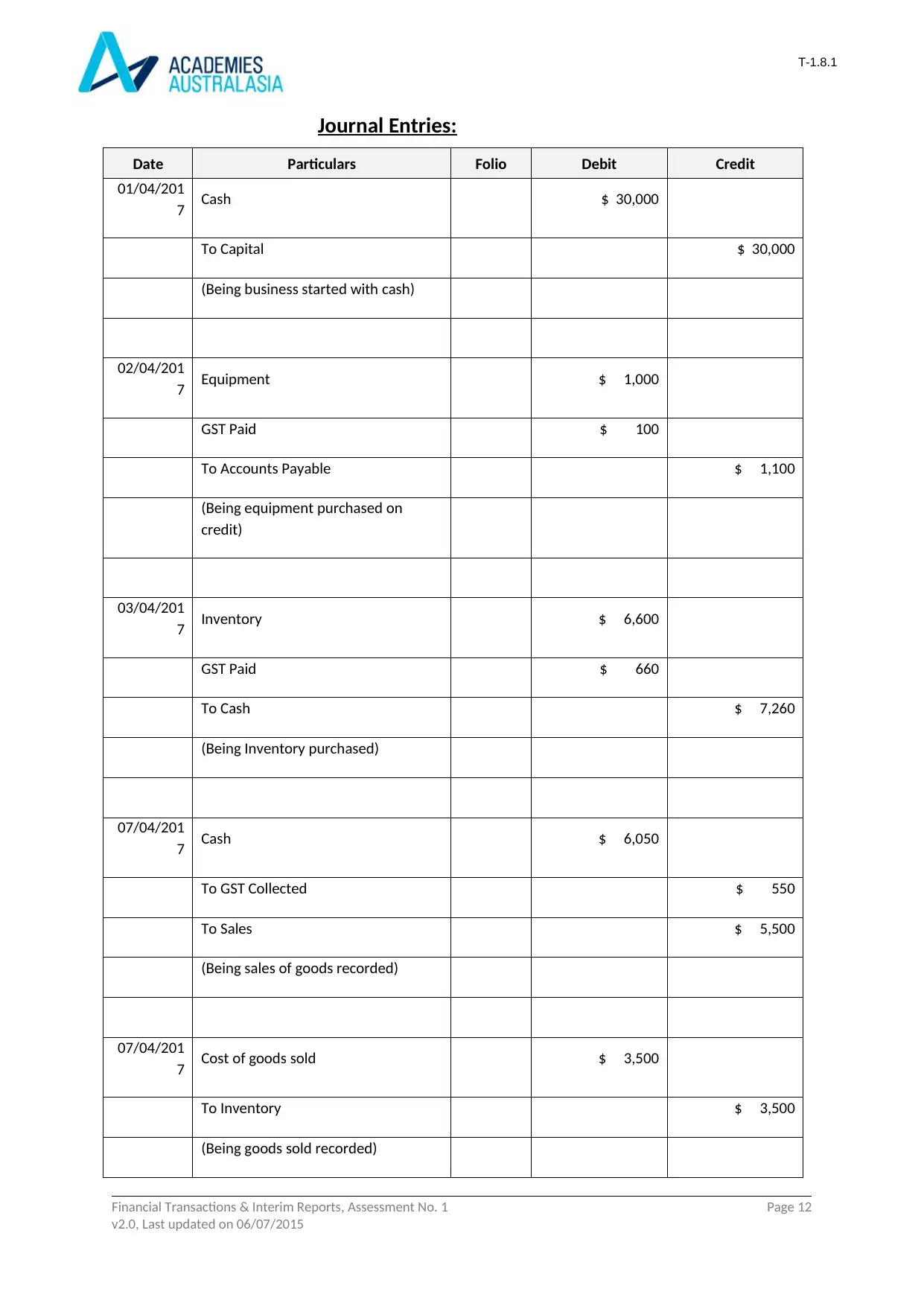
T-1.8.1
Journal Entries:
Date Particulars Folio Debit Credit
01/04/201
7 Cash $ 30,000
To Capital $ 30,000
(Being business started with cash)
02/04/201
7 Equipment $ 1,000
GST Paid $ 100
To Accounts Payable $ 1,100
(Being equipment purchased on
credit)
03/04/201
7 Inventory $ 6,600
GST Paid $ 660
To Cash $ 7,260
(Being Inventory purchased)
07/04/201
7 Cash $ 6,050
To GST Collected $ 550
To Sales $ 5,500
(Being sales of goods recorded)
07/04/201
7 Cost of goods sold $ 3,500
To Inventory $ 3,500
(Being goods sold recorded)
Financial Transactions & Interim Reports, Assessment No. 1 Page 12
v2.0, Last updated on 06/07/2015
Journal Entries:
Date Particulars Folio Debit Credit
01/04/201
7 Cash $ 30,000
To Capital $ 30,000
(Being business started with cash)
02/04/201
7 Equipment $ 1,000
GST Paid $ 100
To Accounts Payable $ 1,100
(Being equipment purchased on
credit)
03/04/201
7 Inventory $ 6,600
GST Paid $ 660
To Cash $ 7,260
(Being Inventory purchased)
07/04/201
7 Cash $ 6,050
To GST Collected $ 550
To Sales $ 5,500
(Being sales of goods recorded)
07/04/201
7 Cost of goods sold $ 3,500
To Inventory $ 3,500
(Being goods sold recorded)
Financial Transactions & Interim Reports, Assessment No. 1 Page 12
v2.0, Last updated on 06/07/2015
⊘ This is a preview!⊘
Do you want full access?
Subscribe today to unlock all pages.

Trusted by 1+ million students worldwide
1 out of 48
Related Documents
Your All-in-One AI-Powered Toolkit for Academic Success.
+13062052269
info@desklib.com
Available 24*7 on WhatsApp / Email
![[object Object]](/_next/static/media/star-bottom.7253800d.svg)
Unlock your academic potential
Copyright © 2020–2025 A2Z Services. All Rights Reserved. Developed and managed by ZUCOL.




